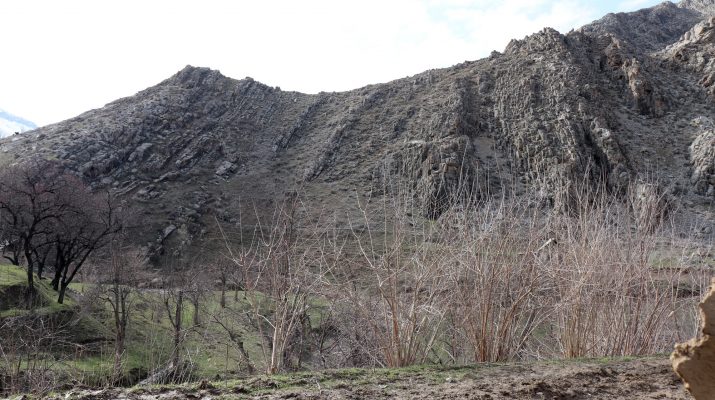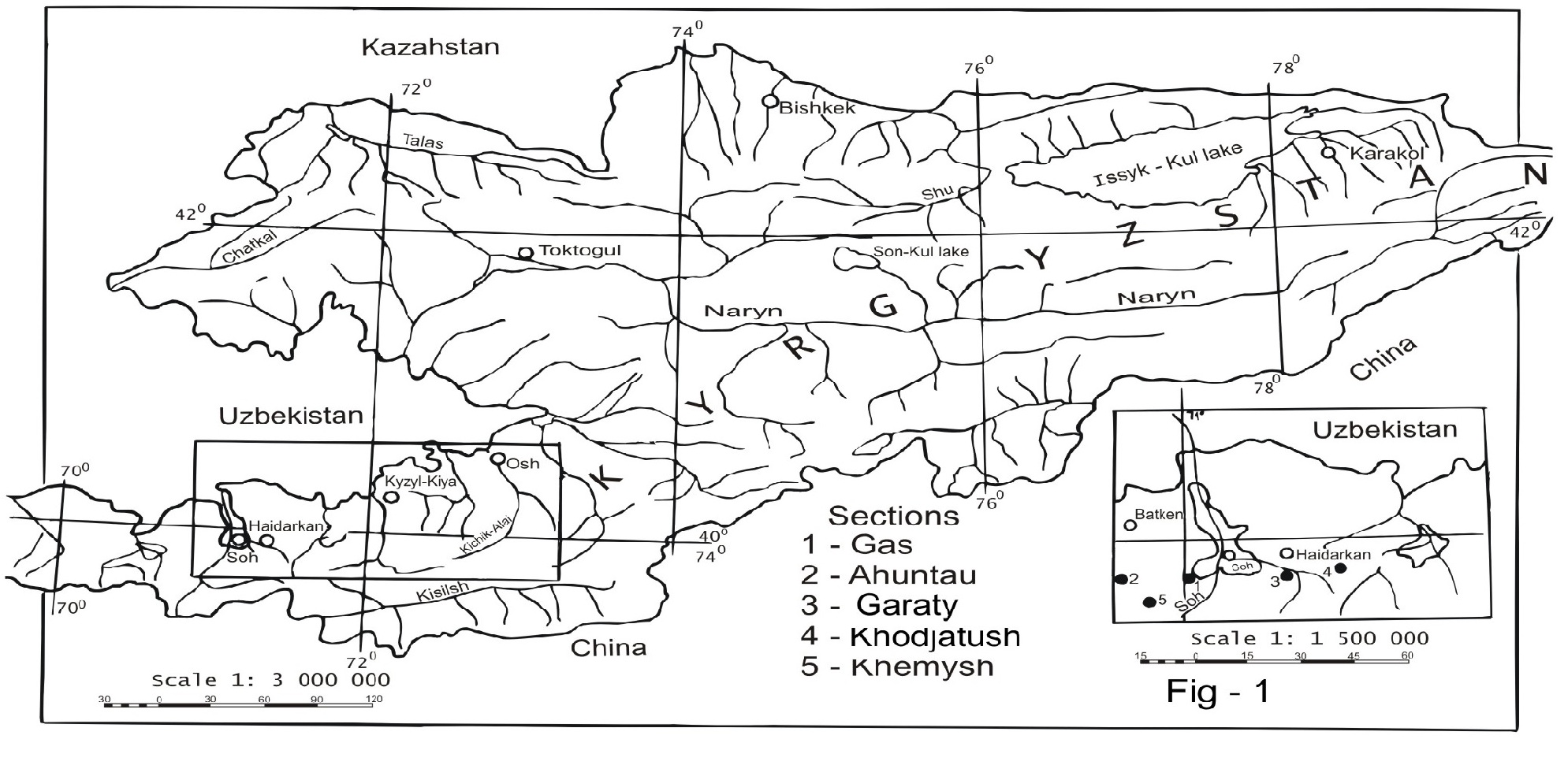International geological expedition to Geopark “Madygen”. Exploration of the stratigraphic section “Gas” – Geological heritage of International importance. Global Boundary Stratotype Section and Points (GSSPs) between the Bashkir and Moscow stages, South Tian-Shan, Kyrgyzstan
We invite researchers to take part in a paleontological and stratigraphic expedition to the South Tian-Shan in August 2024. The expedition is being conducted jointly with the Tian-Shan Geological Society.
Expedition dates: August 12 – September 01, 2024
Kyrgyzstan is actively involved in the development of Geoparks. The country occupies almost the entire western part of the Tian-Shan, with enormous potential for the development of geoparks and geological tourism.
The Tian-Shan has a long geological history, from the Proterozoic to modern Quaternary rocks.
Geopark Madygen is an excellent opportunity for international cooperation between specialists in stratigraphy, paleontology, and geology in general.
Upper Paleozoic deposits occupy a special place in the geological sections of the Southern Tian-Shan. According to geologists who have devoted themselves to the study of Central Asia, these sections can claim to be global reference stratotypes. At the same time, the border between the Bashkir and Moscow stratigraphic stages of the Carboniferous period in the southwestern Tian-Shan may become a place for a new “Golden spike”.
The main merit and research results belong to a group of scientists led by Dr. A. DZHENCHURAEVA from the National Academy of Sciences of Kyrgyzstan.
In this regard, we are organizing a joint international expedition in order to obtain an extended opinion of international experts on the “Gas” section, and to obtain official international recognition of the International commission on stratigraphy.
Rationale:
The main results of the conducted studies of foraminifera and stratigraphy of the Middle Carboniferous deposits of the high foothills of the Turkestan-Alai of the South Tian-Shan are as follows:
- A detailed biostratigraphy scheme of the Bashkir and lower half of the Moscow stages was created. According to this scheme, the Bashkirian Stage is subdivided into seven foraminiferal zones: the Plectostaffella bogdanovkensis Zone, the Plectostaffella seslavica – Semistaffella inconstans Zone, the Pseudostaffella antiqua Zone, the Pseudostaffella praegorskyi Zone, the Profusulinella primulinovichi. The Moscow Stage, the lower substage is subdivided into three zones: the Aljutovella aljutovica – Eofusulina triangula Zone, the Priscoidella priscoidea Zone, and the Pulchrella subpulchra – Moellerites bedakensis Zone.
- Species-indexes (markers) have been established for drawing the interlayer boundary between the deposits of the Bashkir and Moscow stages in the South Tian-Shan. Highlighted markers will help to establish the “golden spikes” in the geochronological timeline.
Justification of the border between the Bashkir and Moscow stages in the Southern Tian-Shan
Currently, the International Working Group on the selection and substantiation of the GSSP of the lower boundary of the Moscow Stage of the International Stratigraphic Scale (ISS) is working to identify species-markers of this boundary in stratotype sections, as well as in areas where the deposits of the Bashkir and Moscow stages are fully represented.
In this regard, an analysis of the border Bashkir-Moscow foraminiferal assemblages in the Southern Tian-Shan was carried out. As a result of the analysis, it was found that the representatives of the evolutionary lines Tikhonovichiella tikhonovichi – Aljutovella aljutovica, Verella spicata – Eofusulina triangula, Depratina praeprisca – D. prisca are the most important for substantiating this boundary. This boundary is characterized by the simultaneous appearance in the upper zone of the Bashkirian stage of the species Verella spicata, Tikhonovichiella tikhonovichi, and Depratina praeprisca, and since the beginning of the Moscow Age, Eofusulina triangula, Aljutovella aljutovica, and Depratina prisca. This situation is recorded in all five sections studied. In some other regions of the world – Turkey, Spain, Donbass, the level of the boundary between the Bashkir and Moscow stages is similar to that in the Southern Tien Shan. There, this border is also drawn according to the joint appearance of the species Eofusulina triangula, Aljutovella aljutovica, Depratina prisca.
However, the stratotype sections of the Moscow syneclise contain representatives of the evolutionary lines Tikhonovichiella tikhonovichi – Aljutovella aljutovica and Depratina praeprisca – Depratina prisca, but there are no representatives of the line Verella spicata – Eofusulina triangula. A similar situation can be traced in the Southern Urals, where the beginning of the Moscow Stage is established by the appearance of the species Aljutovella aljutovica and Depratina prisca, where representatives of the line Verella spicata – Eofusulina triangula are also absent.
Considering that the stratotype of the Bashkirian stage is located in the Urals, and the Moscow stratum – in the Moscow region and there are no verellas or eofusulin there, apparently, this evolutionary line cannot have a correlation potential comparable to the species Aljutovella aljutovica and Depratina prisca. So, one of these two species Aljutovella aljutovica or Depratina prisca can be used as a marker of the lower boundary of the Moscow Stage. For the Tien Shan, along with marker species, representatives of the evolutionary line Verella spicata – Eofusulina triangula will undoubtedly play a large correlation role.
As a result of studying the Bashkir-Moscow deposits in Turkestan-Alai (South Tian-Shan), it was found that:
- Carbonate sedimentation continued throughout the Bashkir-Moscow time;
- A detailed study of the distribution of foraminifera in 5 studied sections made it possible to establish 7 foraminiferal zones in the Bashkirian: Plectostaffella bogdanovkensis, Plectostaffella seslavica – Semistaffella inconstans, Pseudostaffella antiqua, Pseudostaffella praegorskyi, ): Aljutovella aljutovica, Aljutovella priscoidea, Fusulinella subpulchra.
- Analysis of foraminiferal zones of the boundary Bashkir-Moscow interval made it possible to establish three evolutionary lines of species development: Verella spicata –Eofusulina triangula, Depratina praeprisca –D. prisca and Tikhonovichiella tikhonovichi, all of which were identified in the Southern Tien Shan. However, for world marker species we recommend only the last two lines, Depratina praeprisca –D. prisca and Tikhonovichiella tikhonovichi.
The last biostratigraphic scheme for the Carboniferous of Kyrgyzstan was drawn up in 1990 during the implementation of the project “Compilation of regional stratigraphic schemes of the Precambrian and Paleozoic of Kyrgyzstan. The biostratigraphic scheme was drawn up according to the definitions of fossil fossils of orthostratigraphic groups – foraminifera, conodonts and brachiopods. These fossil remains were found, identified and described from the reference sections “Gaz”, “Akhuntau”, “Kshemysh”, “Khojatush”, “Garaty” located in the Alay and Turkestan ridges of the South Tian-Shan. Based on the study of foraminifera and conodonts in these sections, a scheme of subdivision of the Lower – Middle Carboniferous was developed. The Upper Carboniferous was studied using foraminifers from the reference sections of the Karachatyr Ridge of the Southern Tian-Shan.
The proposed biostratigraphic scheme was correlated with similar schemes in other regions of Central Asia. This scheme was supposed to be approved at a meeting of the Regional Interdepartmental Stratigraphic Committee (RISC), but due to the collapse of the Soviet Union, this committee ceased to exist. Therefore, in our further work, we used this biostratigraphic scheme in an unapproved version.
However, further work on the study of the Carboniferous of the Middle Tian-Shan (reference sections “Akbeit”, “Kojagul”, “Ichke”) made it possible to obtain new materials that made adjustments to the existing biostratigraphic scheme.
In the northeastern part of the Northern Tian-Shan, reference carbonate sections (Boordu, Tekes, Tyup) were also studied, which made it possible to supplement the characteristics of the Middle Carboniferous of the biostratigraphic scheme.
In addition, the study of the tier boundaries in the Carboniferous of the world, which began in recent years, with the aim of staking them out with “golden nails”, made it possible to attract this huge material for solving this issue.
All this led to our research on the paleontological substantiation of the biostratigraphic scheme of the Carboniferous of Kyrgyzstan.
Thus, we argue that the reference stratigraphic boundary between the Bashkir and Moscow stages and the point of the global stratotype of the boundary is located in the southern Tian-Shan of Kyrgyzstan.
Expedition objectives:
Research and obtaining materials about the geological heritage to justify the nomination dossier for the inclusion of the geological section “Gas” in the List of International Importance.
Confirm the belonging of geological sections to the international stratigraphic standard-standard for the lower boundary of the Moscow Stage of the Upper Devonian or a Global Boundary Stratotype Section and Points (GSSPs).
- Reconstruction of geological history,
- Use modern methods for a detailed study of the stratigraphic boundary between the Bashkir and Moscow stages of the Carboniferous period,
- Research of markers,
- Justification of the world-standard stratigraphic boundary between the Bashkir and Moscow stages,
- Obtaining reliable data for the advancement of stratigraphic sections of sediments as a stratotype (reference),
- An important goal of the expedition is to confirm the uniqueness of geological sections as custodians of the international stratigraphic standard-standard in the South Tian-Shan,
- To teach the recognition of the international geological community.
Expedition program:
We invite everyone to take part in the international expedition “Gas-2022”. An International expedition is scheduled for August 2022. Further research will continue for several years to obtain representative materials to substantiate the stratigraphic boundary.
The results of other studies will be very useful and necessary for the creation of a geological museum on the territory of the future Geopark.
We want to receive materials for joint publications in world scientific journals.
We will welcome all interested paleontologists, biologists, geologists and others.
Expedition duration: 20 days
- Days 1 – 2. Meeting at the airport of Osh city. Hotel accommodation. Briefing, discussion, acquaintance
- Day 3. Drive to the field camp in the Gaz village
- Days 4 – 18. Field research in geological sections in the Geopark
- Day 19. Return to Osh
- Day 20. Transfer Osh – Airport. Homecoming
We will be glad to Welcome scientific centers, associations, researchers who are ready to participate in scientific research on the expedition.
The expenses for participation in the field expedition will be used for renting transport, purchasing food, paying for the cook and technical staff in the field camp, consumables for the expedition, for accommodation in hotels, guest houses and the field camp.
GeoExplorersClub will provide participants with the necessary field equipment and create comfortable conditions for field work.
– We will provide the field camp with the necessary equipment: tents, kitchen, laboratory tents, shower, toilet, electric generator, etc.
– We will provide visa support,
– We will obtain official permits for legal research, sampling and minerals,
– We will provide the necessary logistics, meeting at the airport, etc.
We will create a good and friendly environment for collaborative research.
Those wishing to take part in the expedition can inform by email: info@geoexplorersclub.com
Welcome to the southwestern Tian-Shan!


